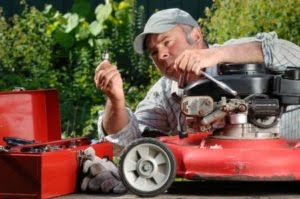 There are many benefits to winterizing your equipment this season.
There are many benefits to winterizing your equipment this season.
Cold weather woes can mean hard starts for equipment that must keep operating. And winter’s woes can continue producing unseen damage to equipment you’re storing until spring’s arrival.
Before you put all of your equipment away for winter storage or use, take the time to prepare all systems to withstand the cold winter months.
How to Winterize Lawn and Garden Power Equipment
Power equipment, such as lawn mowers, tillers, and chippers require additional winter preparations. Always refer to the owner’s manual for specific information. However, in general, the following steps can be taken to winterize lawnmowers.
Wipe the equipment to remove collected grease, dirt, and plant material. Theoretically, this should be done after each use. Tighten loose screws and nuts.
Sharpen cutting edges and wipe with an oily rag if this wasn’t done earlier. If your equipment has a four-cycle engine, change the oil by following instructions listed in your owner’s manual.
Remove all gasoline from the tank by running the engine until it stops or remove most of the gasoline with a meat baster and run it until it stops. Remove the spark plug and squirt a little oil into the cylinder head. Give the engine a turn or two to coat the cylinder walls with oil, and then replace the plug.
Two-cycle engines, or engines that run with a gas and oil mixture, also should have the oil-gas mixture removed for the winter. Run the engine with the choke open to remove fuel from the lines. Check the spark plug and replace if it is worn. Replace other worn or damaged parts as well.
Avoid storing gasoline over the winter. Old gasoline does not ignite easily, making the machines using it work harder.
6 STEPS TO WINTERIZE EQUIPMENT
Winterizing equipment can save you time when you need it most during busy seasons and can reduce the expense of repairs, says Mark Hanna, Iowa State University Extension. “It’s a lot easier to take care of things when you have extra time during the off season,” he adds.
1. Run winter fuel
If you’re running diesel equipment, it’s time to switch from #2 diesel to #1. Your dealer has already changed the blend with the weather, so the only time this becomes a real issue is if you’ve had a tractor sitting around since August or September. “You may have problems with fuel gelling if you still have #2 diesel left in there,” says Hanna: #1 diesel fuel has a lower cloud point, so it gels at a lower temperature than #2 diesel. However, #2 diesel has more energy content per gallon, which is why you run it most of the year.
If you have smaller gasoline engines on the farm, you also want to make sure you have a winter blend in this equipment.
2. Check fluids
Make sure the engine coolant will work for your expected winter temperatures. On smaller outdoor equipment, you may need to go to a lighter weight oil. Check your operator’s manual to see the recommendation.
You should also top off fuel and hydraulic oil tanks. Condensation in the spring can cause water to enter tanks if they aren’t full.
3. Charge or disconnect batteries
For batteries, you have two options. Either keep the batteries as fully charged as possible – a good idea if you may need to use that piece of equipment this winter. Or disconnect the battery. “If the battery is fully charged and you maintain that charge, you are probably OK that way,” advises Hanna. “If the battery is on a piece of equipment you aren’t going to use much this winter, then disconnect the battery so you don’t have a leak.”
4. Store DEF in original container
If you have diesel exhaust fluid (DEF) in a fuel trailer or delivery tote and the equipment could be exposed to freezing temperatures, you need to winterize the system. DEF freezes at 12°F. and expands by 7%, which can damage the pump, plumbing, and tank unless you remove all of the fluid. Thunder Creek Equipment recommends a four-step approach to protect your equipment.
First of all, empty the DEF tank. The easiest way to do this is to top off equipment. Let the nozzle run dry for 30 seconds to make sure all of the fluid is out. Second, set the valve to fill, turn the pump on, and squeeze nozzle for 30 seconds. Next, remove any DEF remaining in the coupler. Last, test the nozzle. Pull the nozzle up and pull the connector. Only a few drops should come out. If you have more than that, you should repeat all four steps.
At this point, any fluid in the pumping system will be in the bottom of the tank. This is all right for transport totes, but trailers will need to be drained. To do this, simply remove the drain plug on the tank, let fluid out, and then replace plug. If you need to use DEF during the winter, heating systems are available.
The good news is that SCR systems and DEF tanks on diesel-powered equipment don’t require any steps to winterize. When the machine is turned off, the system purges the fluid paths, injectors, and pumps so DEF is only in the on-board tank. If the fluid does freeze, these tanks are built to withstand expansion. The systems also have heaters so when the engine starts, any frozen DEF is thawed before the SCR system engages.
5. Clean equipment
It’s probably too late for a good power washing, unless you have a heated place to wash, but you need to make sure that plant debris and dirt are cleaned off equipment. “Plant debris tends to draw and hold moisture,” says Hanna. “If it’s in close proximity to steel, you are just helping things rust a little faster.”
Keeping equipment clean will also help keep pests away, particularly from wiring. Hanna recommends taking the time now to vacuum and clean out combine cabs and make sure planters are clean. “A good thorough cleaning now can save you potential repair costs later on,” adds Hanna.
6. Take time to repair
“When harvest season was done, you were probably glad to get the last load in and get the combine put in the shed,” says Hanna. “You had 15 other tasks in front of you at the time. Now may be a good time to go back and spend an hour or two looking the combine over and seeing what may need some attention before harvest season next year.”
Inspect your combine, tillage equipment, planters, and sprayers. Look at the frame and structure to see if there are broken welds or anything that needs to be fixed. Are the planter closing wheels out of alignment? Do you have any wear points on your tillage equipment? Do you have any loose bolts? Does the equipment need lubrication? “The reason you’re looking over the equipment is that it’s a good time to make some notes on what needs attention during the next three to four months before spring fieldwork season begins,” says Hanna. In other words, take advantage of the extra time you have now, and get your equipment ready to go.

